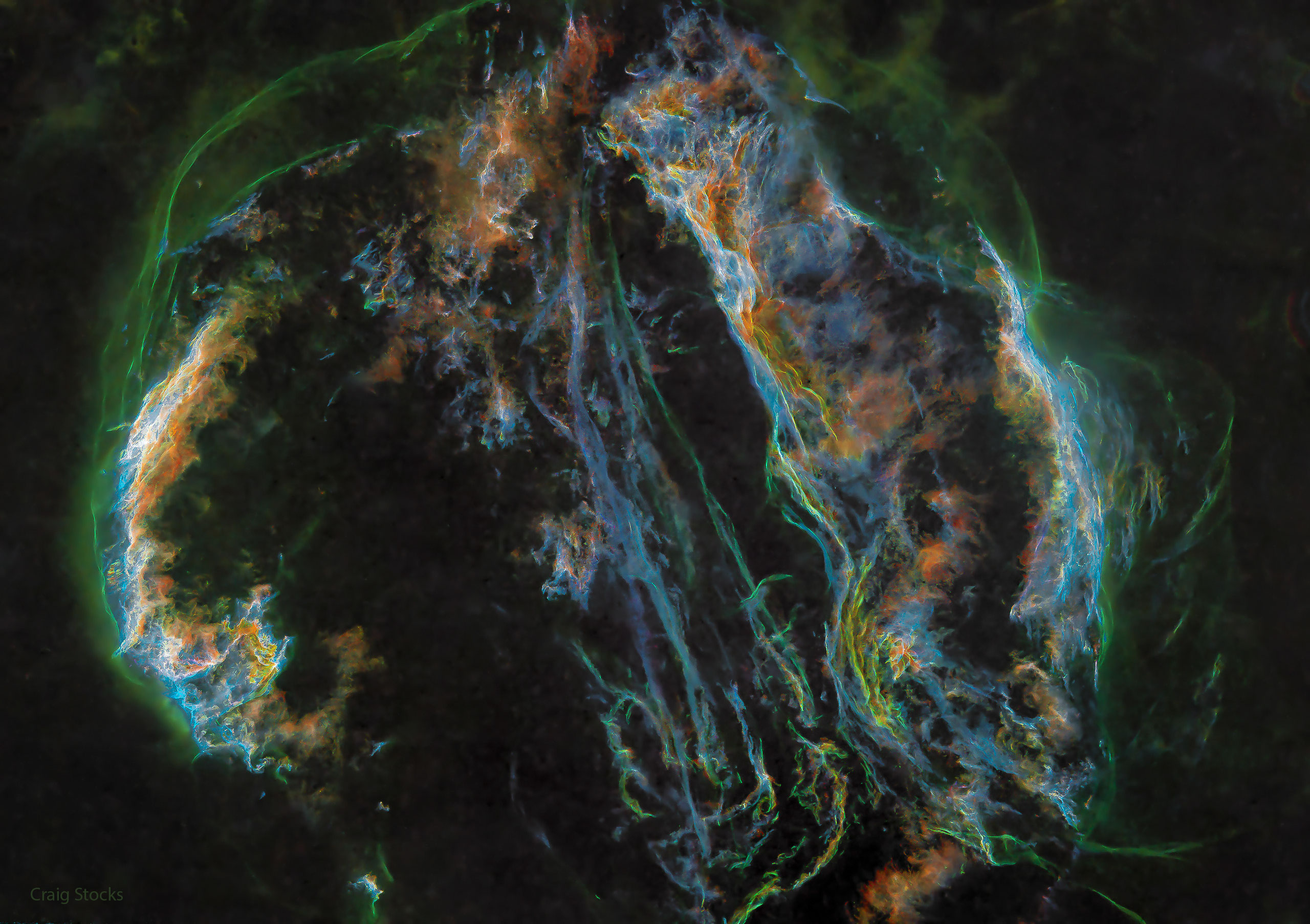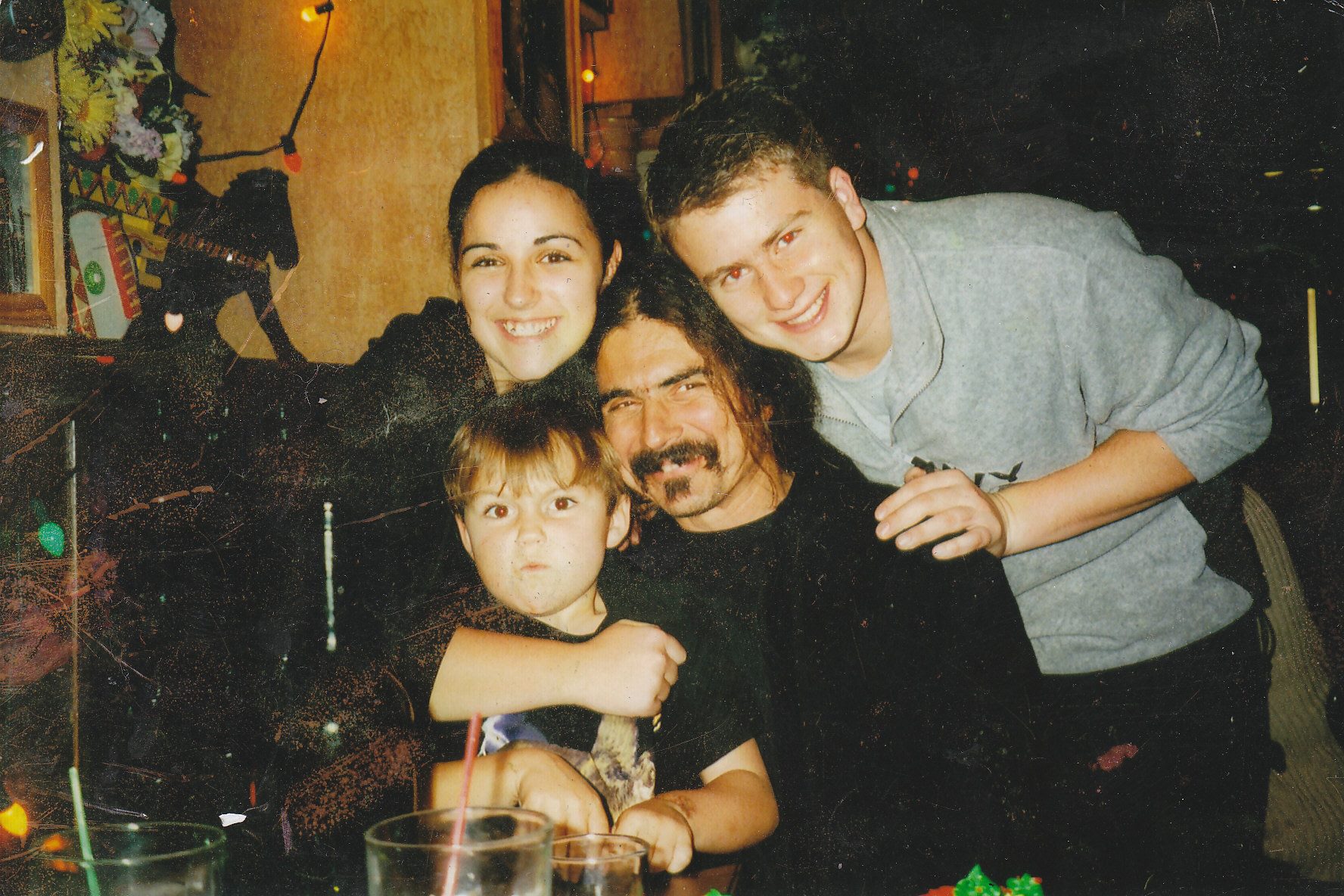Blog
https://www.rcaanc-cirnac.gc.ca/…/1100100…/153487458315
Ten thousand years ago, before the dawn of recorded human history, a new light would have suddenly have appeared in the night sky and faded after a few weeks. Today we know this light was from asupernova, or exploding star, and record the expanding debris cloud as the Veil Nebula, a supernova remnant. Imaged with color filters featuring light emitted by sulfur (red), hydrogen (green), and oxygen (blue), this deep wide-angle view was processed to remove the stars and so better capture the impressive glowing filaments of the Veil. Also known as the Cygnus Loop, the Veil Nebula is roughly circular in shape and covers nearly 3 degrees on the sky toward the constellation of the Swan (Cygnus). Famous nebular sections include the Bat Nebula, the Witch’s Broom Nebula, and Fleming’s Triangular Wisp. The complete supernova remnant lies about 1,400 light-years away.

Todd Harry Rundgren (born June 22, 1948) is an American multi-instrumentalist, singer, songwriter, multimedia artist, sound engineer and record producer who has performed a diverse range of styles as a solo artist and as a member of the band Utopia. He is known for his sophisticated and often unorthodox music, his occasionally lavish stage shows, and his later experiments with interactive entertainment. He also produced music videos and was an early adopter and promoter of various computer technologies, such as using the Internet as a means of music distribution in the late 1990s.
A native of Philadelphia, Rundgren began his professional career in the mid 1960s, forming the psychedelic band Nazz in 1967. Two years later, he left Nazz to pursue a solo career and immediately scored his first US top 40 hit with “We Gotta Get You a Woman” (1970). His best-known songs include “Hello It’s Me” and “I Saw the Light” from Something/Anything? (1972), which get frequent air time on classic rock radio stations, and the 1983 single “Bang the Drum All Day“, which is featured in many sports arenas, commercials, and movie trailers. Although lesser known, “Couldn’t I Just Tell You” (1972) was influential to many artists in the power pop genre. His 1973 album A Wizard, a True Star remains an influence on later generations of bedroom musicians.
Rundgren is considered a pioneer in the fields of electronic music, progressive rock, music videos, computer software, and Internet music delivery.He organized the first interactive television concert in 1978, designed the first color graphics tablet in 1980, and created the first interactive album, No World Order, in 1994. Additionally, he was one of the first acts to be prominent as both an artist and producer. His notable production credits include Badfinger‘s Straight Up (1971), Grand Funk Railroad‘s We’re an American Band (1973), the New York Dolls‘ New York Dolls (1973), Meat Loaf‘s Bat Out of Hell (1977), and XTC‘s Skylarking (1986). He was inducted into the Rock and Roll Hall of Fame in 2021.
more...Hermeto Pascoal (born June 22, 1936) is a Brazilian composer and multi-instrumentalist. He was born in Lagoa da Canoa, Alagoas, Brazil. Pascoal is a significant figure in the history of Brazilian music, mainly known for his abilities in orchestration and improvisation, as well as being a record producer and contributor to many Brazilian and international albums. Pascoal comes from northeastern Brazil, in an area that lacked electricity at the time he was born. He learned the accordion from his father and practised for hours indoors as, being albino, he was incapable of working in the fields with the rest of his family.
Hermeto’s career began in 1964 with appearances on several Brazilian recordings alongside relatively unknown groups. These now-classic albums and the musicians involved (Edu Lobo, Elis Regina, Cesar Camargo Mariano) established widely influential new directions in post-bossa nova Brazilian jazz.
more...Raymond Mantilla (June 22, 1934 – March 21, 2020) was an American percussionist
Ray Mantilla, a percussionist and bandleader who led a prolific jazz career for more than half a century, died on Saturday, at New York-Presbyterian/Columbia University Medical Center. He was 85. The cause was complications of lymphoma, said his brother, Kermit Mantilla, who was at his bedside when he passed.
Mantilla played on hundreds of recordings, including some that have become important parts of jazz history, like Max Roach’s M’Boom, Herbie Mann’s Flute, Brass, Vibes and Percussion and Charles Mingus’s Cumbia & Jazz Fusion. He was one of the three most recorded conga players in the history of jazz; he held that distinction with Ray Barretto and Cándido Camero.
Like Cándido, one of his heroes, Mantilla championed the use of multiple congas, employing up to four drums at times, each tuned to a specific pitch. Also like Cándido, he championed the performance of solo pieces on congas.
But Mantilla was, as he liked to put it, the complete percussionist — skilled not only on congas but also a range of other instruments. “I loved the way Ray played charanga-style timbales,” Barretto once said. “Remember, you have only one bell to keep time accompanying the flute and violins, and you have to play rock-solid time with swing.”
Mantilla described his own music as “Latin Jazz with authentic Latino rhythms.” He released nine albums as a leader. His first was Mantilla, in 1978, and his most recent was High Voltage, almost 40 years later. He recorded a follow-up, Rebirth, scheduled for release this year on Savant Records.
“It’s a combination of the familiar and the eclectic,” said longtime Mantilla associate Mike Freeman, who plays vibraphone on that album. The title, Rebirth, he explained, “is a reference to Ray surviving cancer two years ago.”
Raymond Mantilla was born in St. Francis Hospital in the South Bronx on June 22, 1934. His father, Carlos Mantilla Ghilardi, was an architect and engineer who was recruited to work on the building of the George Washington Bridge. He then began working for the U.S. Intelligence Services in a branch in Peru, just before the United States’ entry into World War II. Ray’s mother, Ramona Maldonado, hailed from the city of Vega Baja in Puerto Rico, and owned and operated a bodega in the South Bronx. Ray’s childhood friends included some of the major forces in the Afro-Cuban music scene that became redefined by New York’s City’s Puerto Rican community into what we know as salsa. Among them were timbalero Orlando Marin, percussionist Manny Oquendo, pianist Eddie Palmieri, flutist and percussionist Johnny Pacheco, and percussionist Benny Bonilla.
Bonilla, who played timbales on the seminal Latin Boogaloo hit “I Like It Like That,” met Mantilla at age 15. “He and I would practice our conga beats to 78 vinyl records,” he said. “Ray stressed a steady and good left hand.”
But Mantilla’s closest childhood friend was Barretto, a pioneering conga player who became an NEA Jazz Master in 2006, one month before his death at 76. “Me and Ray were like peas in a pod,” Mantilla once recalled. “He got me into the studios, since he would send me to cover dates he couldn’t do. Between Ray, Johnny Pacheco, Willie Rodriguez, Cándido, and me, we were doing all the Latin percussion work on studio sessions in New York.”
Barretto also made a fateful introduction when he recommended Mantilla to Mann, a flutist leading a widely popular Latin jazz band. Barretto and Mantilla played together on a handful of albums by Mann at the dawn of the ‘60s, including The Common Ground and The Family of Mann — but by the time of Herbie Mann at The Village Gate in ’61, Barretto had moved on, and given Mantilla his blessing.
His work with Mann, and his association with Barretto, brought Mantilla to the attention of prominent jazz bandleaders like Mingus, Roach, Art Blakey and many more. “I always liked the freedom in jazz and I dug the scene as well,” he said. “You could be more creative, looser. After a while I just stopped doing gigs on the Latin scene altogether unless I was called as a guest soloist.”
In 1972, Mantilla was asked to join Roach’s percussion ensemble M’Boom, which had been formed two years earlier. “I was impressed by Ray when I saw him with Art Blakey because I liked the way he navigated his role in the group,” recalls founding member Joe Chambers, who recommended him for the gig. “He demonstrated the drummer’s philosophy as it was taught to me, to accompany. He never overplayed.”
Warren Smith, another member of M’Boom, recalls: “Ray understood the subtle nuances in African, Latin, and jazz-based music and he adapted beautifully. The first time he played with us it was seamless. What also impressed me was the variety of solo contexts he could do. He could play solo on bongos, congas, whatever, and hold the audience. He was also funny as an emcee. When we performed in Barcelona, Max let him speak to the audience in Spanish. He had them in the palm of his hand introducing each one of us with funny quips and jokes.”
For Mantilla, M’Boom was an opportunity to expand his musicianship. “I had to learn to play mallet parts on vibes, xylophone, etc. I had never done that before. It was great. They showed me that and I had a chance to show the guys how to play hand drums and the percussion in an authentic way.”
In 1977, Mantilla also made political history, as part of a group of musicians led by Dizzy Gillespie who became the first to perform in Cuba since the travel embargo of 1962. Their joint concerts with Cuba’s supergroup Irakere and the rúmba percussion ensemble Los Papines would reestablish musical ties with the island.
It was the following year, 1978, that Mantilla really became a bandleader. His group, which he eventually dubbed the Space Station, explored Afro-Cuban-based rhythms but also experimented with expanding the parameters of the music, notably with odd meters. “I was into that when nobody else was, other than people like Don Ellis,” Mantilla said. “That’s why on that album you hear things in seven, etc. Nobody in Latin jazz was doing that at all. That’s why I would call the group Space Station. We were doing things that were out of the norm.”
more...https://www.youtube.com/watch?v=ibllVBW_RHc
more...Nils Hilmer Lofgren (born June 21, 1951) is an American rock musician, recording artist, songwriter, and multi-instrumentalist. Along with his work as a solo artist, he has been a member of Bruce Springsteen‘s E Street Band since 1984, a member of Crazy Horse, and founder/frontman of the band Grin. Lofgren was inducted into the Rock and Roll Hall of Fame as a member of the E Street Band in 2014.
more...Boris Claudio “Lalo” Schifrin (born June 21, 1932) is an Argentine-American pianist, composer, arranger and conductor. He is best known for his large body of film and TV scores since the 1950s, incorporating jazz and Latin American musical elements alongside traditional orchestrations. He is a five-time Grammy Awardwinner, and has been nominated for six Academy Awards and four Emmy Awards.
more...Nehemiah Curtis “Skip” James(June 9, 1902 – October 3, 1969) was an American Delta blues singer, guitarist, pianist and songwriter. His guitar playing is noted for its dark, minor-key sound, played in an open D-minor tuning with an intricate fingerpicking technique. James first recorded for Paramount Records in 1931, but these recordings sold poorly, having been released during the Great Depression, and he drifted into obscurity. James was born near Bentonia, Mississippi. His father was a bootlegger who reformed and became a preacher. As a youth, James heard local musicians, such as Henry Stuckey, from whom he learned to play the guitar, and the brothers Charlie and Jesse Sims. James began playing the organ in his teens.
more...Perseus A, also called NGC 1275, is an eruptive galaxy at the core of the Perseus Cluster, which is made up of some 1,000 galaxies about 240 million light-years away. The dominant member of the Perseus Cluster, Perseus A is a Seyfert galaxy with an active nucleus, powered by a 340 million-solar-mass black hole in its core. The behemoth galaxy NGC 1275, also known as Perseus A, lies at the centre of Perseus Galaxy Cluster. By combining multi-wavelength images into this single composite, the dynamics of the galaxy become visible. Detail and structure from optical, radio and X-ray wavelengths have been combined for an aesthetically pleasing image which shows the violent events in the galaxy’s heart. NGC 1275 is an active galaxy well-known for its radio source (Perseus A) and is a strong emitter of X-rays due to the presence of the supermassive black hole in its centre. Hubble data from the Advanced Camera for Surveys covers visible-light wavelengths and is shown in the red, green and blue. Radio data from NRAO’s Very Large Array at 0.91 m was also used. In this composite image, dust lanes, star-forming regions, hydrogen filaments, foreground stars, and background galaxies are contributions from the Hubble optical data. The X-ray data contributes to the soft but violet shells around the outside of the centre. The pinkish lobes toward the centre of the galaxy are from radio emission. The radio jets from the black hole fill the X-ray cavities. Chandra data from the ACIS covers X-ray wavelengths from 0.1771 to 4.133 nm (0.3-7 KeV).

Leslie Johnson (June 20, 1933 – August 22, 2018), better known as Lazy Lester, was an American blues musician who sang and played the harmonica and guitar. His career spanned the 1950s to 2018.
Best known for regional hits recorded with Ernie Young’s Nashville-based Excello Records, Lester also contributed to songs recorded by other Excello artists, including Slim Harpo, Lightnin’ Slim, and Katie Webster. Cover versions of his songs have been recorded by (among others) the Kinks, the Flamin’ Groovies, Freddy Fender, Dwight Yoakam, Dave Edmunds, Raful Neal, Anson Funderburgh, and the Fabulous Thunderbirds. In the comeback stage of his career (since the late 1980s) he recorded new albums backed by Mike Buck, Sue Foley, Gene Taylor, Kenny Neal, Lucky Peterson, and Jimmie Vaughan.
Lester started playing the guitar around age 11 and began performing in his teens around Baton Rouge with Raful Neal, later co-founding the Rhythm Rockers. In the mid-1950s, Lester was on the margins of the Louisiana blues scene. According to Rolling Stone (February 23, 2006), Buddy Guy, before moving to Chicago, had played in Louisiana with some of the old masters: Lightnin’ Hopkins, Lazy Lester, Slim Harpo. When Guy left for Chicago, in 1957, Lester replaced him, on guitar, in a local band – even though Lester, at that time, did not own such an instrument.
more...Eric Allan Dolphy Jr. (June 20, 1928 – June 29, 1964) was an American jazz alto saxophonist, bass clarinetist and flautist. On a few occasions, he also played the clarinet and piccolo. Dolphy was one of several multi-instrumentalists to gain prominence in the same era. His use of the bass clarinet helped to establish the instrument within jazz. Dolphy extended the vocabulary and boundaries of the alto saxophone, and was among the earliest significant jazz flute soloists.
His improvisational style was characterized by the use of wide intervals, in addition to employing an array of extended techniques to emulate the sounds of human voices and animals. He used melodic lines that were “angular, zigzagging from interval to interval, taking hairpin turns at unexpected junctures, making dramatic leaps from the lower to the upper register.” Although Dolphy’s work is sometimes classified as free jazz, his compositions and solos were often rooted in conventional (if highly abstracted) tonal bebop harmony.
Dolphy was born and raised in Los Angeles, California. His parents were Eric Dolphy, Sr. and Sadie Gillings, who immigrated to the United States from Panama. He began music lessons at age six, studying clarinet and saxophone privately. While still in junior high, he began to study the oboe, aspiring to a professional symphonic career, and received a two-year scholarship to study at the music school of the University of Southern California. Aged thirteen, he received a “Superior” award on clarinet from the California School Band and Orchestra festival. He attended Dorsey High School, where he continued his musical studies and learned additional instruments
https://www.youtube.com/watch?v=Lw0ETsYu3_g
more...Chester Burton “Chet” Atkins (June 20, 1924 – June 30, 2001), known as “Mr. Guitar” and “The Country Gentleman“, was an American musician who, along with Owen Bradley and Bob Ferguson, helped create the Nashville sound, the country music style which expanded its appeal to adult pop music fans. He was primarily a guitarist, but he also played the mandolin, fiddle, banjo, and ukulele.
Atkins’s signature picking style was inspired by Merle Travis. Other major guitar influences were Django Reinhardt, George Barnes, Les Paul, and, later, Jerry Reed. His distinctive picking style and musicianship brought him admirers inside and outside the country scene, both in the United States and abroad. Atkins spent most of his career at RCA Victor and produced records for the Browns, Hank Snow, Porter Wagoner, Norma Jean, Dolly Parton, Dottie West, Perry Como, Floyd Cramer, Elvis Presley, the Everly Brothers, Eddy Arnold, Don Gibson, Jim Reeves, Jerry Reed, Skeeter Davis, Waylon Jennings, Roger Whittaker, and many others.
Rolling Stone credited Atkins with inventing the “popwise ‘Nashville sound’ that rescued country music from a commercial slump” and ranked him number 21 on their list of “The 100 Greatest Guitarists of All Time”. Among many other honors, Atkins received 14 Grammy Awards and the Grammy Lifetime Achievement Award. He also received nine Country Music Association awards for Instrumentalist of the Year. He was inducted into the Rock & Roll Hall of Fame, the Country Music Hall of Fame and Museum, and the Musicians Hall of Fame and Museum. George Harrison was also inspired by Chet Atkins; early Beatles songs such as “All My Loving” show the influence.
Atkins was born on June 20, 1924, in Luttrell, Tennessee, near Clinch Mountain. His parents divorced when he was six years old, after which he was raised by his mother. He was the youngest of three boys and a girl. He started out on the ukulele, later moving on to the fiddle, but he made a swap with his brother Lowell when he was nine: an old pistol and some chores for a guitar. He stated in his 1974 autobiography, “We were so poor and everybody around us was so poor that it was the forties before anyone even knew there had been a depression.” Forced to relocate to Fortson, Georgia, outside of Columbus to live with his father because of a critical asthma condition, Atkins was a sensitive youth who became obsessed with music. Because of his illness, he was forced to sleep in a straight-back chair to breathe comfortably. On those nights, he played his guitar until he fell asleep holding it, a habit that lasted his whole life. While living in Fortson, Atkins attended the historic[citation needed]Mountain Hill School. He returned in the 1990s to play a series of charity concerts to save the school from demolition. Stories have been told about the very young Chet who, when a friend or relative would come to visit and play guitar, crowded the musician and put his ear so close to the instrument that it became difficult for the visitor to play.
more...James Corbitt Morris (June 20, 1907 – July 12, 1998), known professionally as Jimmy Driftwood or Jimmie Driftwood, was an American folk music songwriter and musician, most famous for his songs “The Battle of New Orleans” and “Tennessee Stud“. Driftwood wrote more than 6,000 folk songs, of which more than 300 were recorded by various musicians.
Driftwood was born in Timbo, Arkansas, United States on June 20, 1907. His father was folk singer Neil Morris.. He is on the album Songs of the Ozarks. Driftwood learned to play the guitar at a young age on his grandfather’s homemade instrument. Driftwood used that unique guitar throughout his career and noted that its neck was made from a fence rail, its sides from an old ox yoke, and the head and bottom from the headboard of his grandmother’s bed. This homemade instrument produced a pleasant, distinctive, resonant sound.
Driftwood attended John Brown College in northwest Arkansas and later received a degree in education from Arkansas State Teacher’s College. He started writing songs during his teaching career to teach his students history in an entertaining manner.
more...More Posts
- Cosmo Alpha Centauri
- Alpha Blondy Praying for Jerusalem
- Milt Jackson
- Slim Gaillard
- Xavier Cugat
- Norberto De Nöah
- Daily Roots Jackie Mitoo
- Happy New Year 2025
- Cosmo NGC 4753
- June Tabor
- Pete Quaife
- Jimmy Haslip
- Jonah Jones
- Odetta
- World Music Fabio Bergamini
- Daily Roots Sister Nancy & Naya Rockers
- New Year Ear 2025
- Cosmo M27
- Del Shannon
- Alessandro Piccinini



